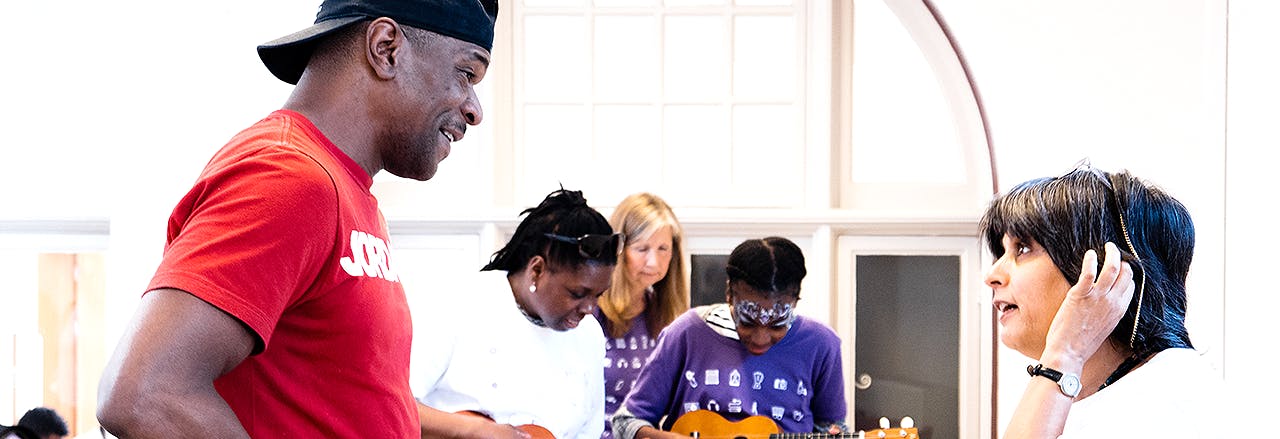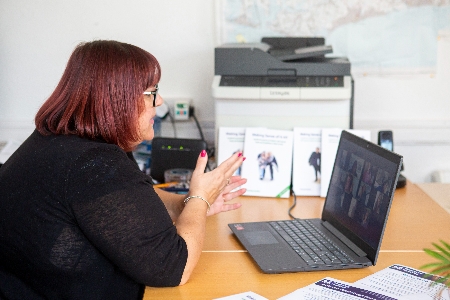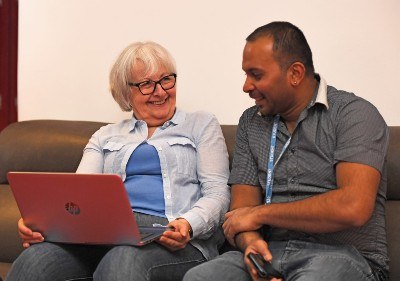
Helplines and advice lines
Helplines and advice lines provide a safe, confidential and expert space to talk about difficult or complex issues. They typically offer a range of information, advice and support services. Some offer a listening ear and signposting to other agencies, others may complement existing services, like the NHS, by offering in-depth or repeat conversations and support about medical or mental health conditions. Advice lines offer more tailored, specialist advice on topics like debt, immigration, domestic abuse or legal matters.
Here we capture ten key things to consider when looking at this form of "remote" service delivery, based on learning from providers of well-established helplines and advice lines.
- 1. Check that your service is needed
- 2. Be clear what your service is and what it offers
- 3. When and how people contact you
- 4. Managing demand
- 5. Getting the right technology
- 6. Put quality and safeguarding measures in place
- 7. Essential skills for staff and volunteers
- 8. Take care of wellbeing
- 9. Offer information resources to complement your work
- 10. Measure impact, capture learning
Listen to this article
You can listen to this article as a sound recording, lasting 24 minutes and 7 seconds, by clicking the button below.
1. Check that your service is needed
Before starting or maintaining a new service, it’s worth checking what’s already available. Existing services might have more experience and capacity, a strong reputation, or be better resourced to deliver long-term. The directory of Helplines Partnership members is a useful starting point.
Is another service already offering specialist support on a similar issue? Consider signposting to them, rather than setting up something new. HeadStart Blackpool planned to set up a helpline as part of their service to support young people's mental health – until young people told them, “Childline is better and free.” Instead, they used the money they would have spent to promote Childline and invest in other wellbeing services.
Explore ways to collaborate with others. Partnerships can improve your service by:
- Ensuring a steady flow of referrals. Parents Against Child Exploitation (PACE) say that parents find out about them from the internet, through referrals from statutory services and children's and young people's charities, and through word-of-mouth.
- Making sure your information is accurate and up to date. During the pandemic, National Kidney Federation’s senior management were part of NHS meetings, so they had the latest advice to pass on to patients – and have continued this practice since.
- Increasing access to specialist advice. The Multiple Sclerosis Society’s partnership with the Disability Law Service offers free legal advice on issues including disability discrimination and community care in England and Wales.
- Get callers to the right destination. Signposting agreements with partners, and the right technology to support them, can prevent callers having to make many calls, saving them time, money, and the stress of repeating their story multiple times.
When you aim to fill a gap in provision, starting small can give you time and space to establish the demand for your service, and what, specifically, callers want. The Muslim Women’s Network UK set up its helpline from an understanding that others weren’t meeting the needs of Muslim women and girls. With an initial small grant, they handled 814 contacts from 335 women in their first year. This helped them secure funding to expand the service, supporting 1,442 callers in 2022.
2. Be clear what your service is and what it offers

Most people use a helpline or advice line at a time of stress or crisis. So it’s important to be clear and specific about what you can and can’t offer. It helps manage people’s expectations, making sure they don’t feel disappointed. You can set this out on your website or in marketing materials.
For example, The Compassionate Friends provide a helpline for bereaved parents and their families. Their website states that people can ring the helpline “once, many times or simply from time to time”, and that it doesn’t matter how long the caller has been bereaved for. “Everyone’s loss and way of grieving is unique so please do phone when you feel the need.”
Helplines and advice lines offer different kinds of support. Helplines offer:
- an impartial listening ear, emotional support, reliable information, and signposting to specialist organisations;
- an opportunity to talk and be listened to;
- reassurance to callers that they aren’t alone in what they are going through, helping people feel heard and understood;
- information and resources that enable people to make more informed decisions for themselves.
But they don’t tell people what actions to take, or undertake work on the caller’s behalf.
Helplines may employ paid staff or use volunteers, sometimes with personal experience of the issue they support. Many volunteers at Survivors of Bereavement by Suicide (SoBs) have lost someone to suicide so, while many callers don’t initially know what they want to talk about, the empathetic approach means they quickly feel able to talk freely.
With National Lottery funding, SoBs have employed a coordinator and paid for training and resources to support volunteers like Josie, who explains, “SoBs offers something that a lot of counselling can’t provide. People who understand what you are going through because they have been in your shoes.”
Advice lines have a different focus. In general, advice lines:
- usually provide specialist, personalised advice on medical, financial or legal matters;
- often outline rights, options, and choices, and give advice on the steps to take to resolve an issue;
- may employ qualified professionals like solicitors or nurses;
- may employ people or volunteers with personal experience of their specialism;
- may offer individual casework.
PACE provides ongoing telephone casework for six to 12 months, plus access to peer support through an online Parent Forum. One parent explained, “PACE helped me to understand exactly what was going on with my daughter and advised me on who was best placed to help. But it was enough just to know that there was somebody there to listen.”
3. When and how people contact you
How will people want to contact you? Advice and helplines were traditionally delivered by telephone, but many are now multi-channel, using other communication tools like email, text messages, online chat, or social media. Some people might prefer the human contact of a phone call, while messaging can offer greater privacy for those worried about being overheard, or who might be less comfortable speaking about their concerns.
It’s important to consider the following:
- Your opening times must be accessible to your users – which might mean evening or weekend working.
- How will you manage fluctuating demand? There may be predictable times of the year when people most need support. Or you might work with people in crisis, or with health conditions that can happen suddenly and unexpectedly.
- Your delivery channels should be accessible to everyone, especially if you’re supporting people with a disability, groups who largely communicate online, or beneficiaries who are only comfortable with the telephone.
- Be clear about what reasonable adjustments people can expect. This may include text relay services for people with hearing impairments, or information in alternative formats like braille or easy read. The FreeVA helpline, which supports survivors of domestic and/or sexual violence, provides a text-based service for people who are deaf or hearing impaired, or who aren’t quite ready to talk.
- You may need to offer interpretation or translation when working with people whose first language is not English or Welsh. Some use third-party services to provide interpreters, or have multi-lingual teams. In Leicester, Adhar Project recognised that some communities were less likely to use English-speaking mental health helplines, due to language and cultural barriers. The project’s helpline connects people to counselling in Hindi, Gujrati, Punjabi, Urdu, Bengali, and English.
- Many charities now use chatbots to answer simpler questions. Remember that people use language differently: how do your service users communicate? Even within a single language, users may be non-native speakers, may speak in a regional dialect, or use slang or unconventional spelling. The chatbot should be set up to respond to how people actually speak and write.
- Decide if you can offer choice to callers. The Compassionate Friends offer the option to talk to a call-handler of the same sex (dad to dad, or mum to mum). Others operate on a strict rota basis, where it is not possible to ask for a named or specific advisor.
Advice and helplines can sit alongside other services. The LGBT Cymru helpline acts as a gateway to further support. This could mean someone to talk to in confidence, support buddying for those who are particularly lonely, or counselling sessions.
4. Managing demand
Think about the likely demand for your service, the pros and cons of different ways of delivering it, and how you will resource this. Multi-channel access helps make your service more inclusive – but comes at a cost, as you need to have enough people to manage all your channels.
Calls offer the most time to discuss issues in detail, compared to text messaging, online chat, or email. But if demand outstrips your ability to reply, you’ll need to think carefully about things like whether to offer a call back service, or how you’ll manage confidentiality.
An unanswered call, or a long wait on hold, can be distressing for callers. Think in advance about how you will mitigate high demand. You can:
- direct people to quieter times via a recorded message or your website;
- use a virtual receptionist service to triage calls;
- provide answers to frequently asked questions online;
- use a chatbot to answer commonly asked questions, signposting users to staff or volunteers if they have more complex problems;
- collect and use data to plan your staffing levels, ensuring more people are working during busy times.
Though they ease pressure on phone lines, these options make their own demands. Emails and texts can come in at any time of the day or night, and may quickly become overwhelming for small organisations. We’ve heard of one organisation receiving 39,000 WhatsApp messages in the first year of introducing the service. This was difficult to manage on top of the 7,000 calls it was used to getting each year.
Be clear about what users can expect when they get in touch, and who – or what – they will be speaking to. The Cyber Helpline offers a clearly identified chatbot as a first step for those affected by digital fraud and online crime. Available 24 hours a day, the chatbot helps 75% of the charity’s users, directing them to expert guides. Volunteers are available if further assistance is required: “If our chatbot can’t diagnose your issue – or you just need more help – it will ask you for your contact details so one of our Helpline Responders can get in touch.”
By contrast, Crohn’s and Colitis UK explain that, even in an online chat, users “will not be chatting with a chatbot here, you will chat with a real person – one of our helpline team members.”
5. Getting the right technology
You may need to invest in new technology if you need a sophisticated way to distribute calls between advisors, transfer people to a partner organisation, offer different channels, or collect call data. The right technology won’t be the same for everyone.
Ask yourself:

- Will your call-handlers work at a fixed location, or between their home and office?
- Who are your callers, and what technology are they comfortable using?
- How important is confidentiality? Do callers need to cover their traces for their own safety?
- How complex are the issues you deal with? Is your preferred tech a suitable channel for this level of detail or complexity?
- Do you need call statistics to help analyse and manage peaks and troughs of demand?
- What reporting do you want to be able to provide to your trustees, donors or funders? What data will you need in order to do this?
Also think about who will cover the cost of the call – you or the caller – and if it’s safe for your number to show up on a caller’s phone bill. The Helplines Partnership offers a range of freephone numbers that are free to call from UK landlines and mobile phones and that are not listed on itemised phone bills. This offers additional confidentiality for vulnerable callers, but the helpline provider bears the cost, so you will need to budget accordingly.
6. Put quality and safeguarding measures in place
Helplines must provide reliable information that is up to date and evidence-based. You also need to pay attention to customer service, so that callers have a positive experience.
Effective policies and processes are important, and what you need will depend on the nature of your service. Here are some basics to consider:
- Are calls confidential? What are the legal requirements on when you may need to breach confidentiality?
- What will happen to any data you collect?
- What will happen if you identify someone as being at risk?
Some services require Disclosure and Barring Service (DBS) checks for staff and volunteers. This happens at Teenage Helpline. It’s largely manned by trained young mentors aged 16–25, providing young people, who don’t yet feel comfortable approaching an adult or professional, someone they can open up to about their relationship, family or school concerns. All mentors, and the safeguarding team who are on hand to help with challenging situations, have to pass a DBS check before starting.
Be sure that you have the right insurance in place. Professional indemnity insurance offers cover in case of legal claims against your services or advice. If you use volunteers, you’ll need to speak to your insurer to arrange cover that includes them in addition to paid staff. Umbrella organisations like NCVO and SCVO offer a range of advice on choosing an insurer.
You’ll also need guidance to help staff make tough decisions around how to manage or end calls that become difficult or abusive, and how to handle repeat or nuisance callers.
Some helplines work towards eternal quality standards to help them continuously improve. A number of standards exist for health information and customer service. The Helplines Standard accredits best practice in helpline work.
Look to others for good practice and advice when you draft your policies. Most helpline managers are generous and willing to share their own policies, while the Helplines Partnership offers helpful resources, like a toolkit on safeguarding.
It is better to provide an effective, well-resourced helpline for a few hours a couple of days a week than a poor-quality, under-resourced service for longer periods of time.Helplines Partnership
7. Essential skills for staff and volunteers

All staff and volunteers need detailed knowledge of their area of specialism, as well as the skills to manage calls well. These include listening, empathy, and supporting callers through difficult emotions.
When recruiting, it’s important to test for the full range of skills. While specialist thematic knowledge can be taught or acquired on the job, attitudes and behaviours may be harder to change. Muslim Women’s Network UK have had to reject some candidates at interview stage because of lack of commitment to their ethical principle of “non-judgmental support”.
A helpline role can mean a very steep learning curve for new staff and volunteers, so it’s vital to support them properly. Initial induction and ongoing training should include:
- Practical skills, like how to use the phone systems, IT, and databases.
- “Soft” skills, like active listening, effective use of questioning, and how to manage difficult calls.
- Specialist, in-depth knowledge of the issues you work with.
These are essential, and require regular updating. Most helplines do this through a mix of induction, regular scheduled training, and ongoing peer support. This might include pairing new advisors with a more experienced buddy, mystery shopping, and call monitoring or recording. You should make it clear if you record calls, and ensure your policies account for this.
Be clear about what is and isn’t acceptable behaviourally too, in order to reduce risks for both the caller (being given subjective, biased, or inaccurate advice) and the call-handler (triggering or reliving past trauma). Openly discussing feedback and learning helps ensure that advisors and confident and equipped to manage a complex range of questions and situations.
Great helpline volunteers do more listening than talking, are comfortable listening to the experiences of others and pay attention to their own well-being and boundaries.Survivors of Bereavement by Suicide
8. Take care of wellbeing
Dealing with calls about upsetting issues, and where people express strong feelings and emotions, can be tough. They may bring back personal memories and experiences for advisors with lived experience of similar issues. So it’s important to support your staff and volunteers to maintain their wellbeing and reduce the risk of burnout, emotional fatigue, or vicarious trauma.
Support could include:
- Healthy working practices, like limiting the length of shifts, scheduling breaks, and routing calls to advisors equitably.
- Debriefing sessions with peers or supervisors at the end of each shift.
- Supervision and support – for example, monthly sessions with a counsellor. Services offering counselling, like Accord NI, ensure clinical supervision is available for their staff.
- Opportunities to support each other, like agreeing non-verbal signals if a colleague needs help or a break.
- Agreeing an amount of time that people with lived experience should wait before they work or volunteer on the helpline, especially if they have faced trauma, neglect, or abuse.
If call-handlers work from home, be aware of the challenges this can present to confidentiality, comfort, and wellbeing, and proactively address these. The Helplines Partnership homeworking toolkit may be useful.
9. Offer information resources to complement your work
Callers often face a complex range of issues, so it can be helpful to share resources, such as factsheets, to review after the call.

These can provide a reminder of the key points raised in the conversation, or break down complex information into more manageable chunks. Or they might offer more detailed information, for those interested.
It's essential to provide information in a range of formats for people who have sensory, cognitive, or communication disabilities. This could include Easy Read, braille, audio recordings, or video.
Online and peer support forums are other useful resources to consider.
If you work with health or social care issues, the Patient Information Forum has resources on best practice in developing information resources, including involving your users and communicating without bias.
10. Measure impact, capture learning
You can learn from conversations with callers, gaining knowledge to inform your organisation’s work. These insights can help you make sure that your information and support reflect the reality of people’s experiences, not just what is written in official guidelines. They can inform your policy work, and give decision makers and commissioners a compelling set of stories about how their policies are affecting people in practice.
This learning can support your aims and purpose, give you credibility, and help you be a critical friend to others in your field. However, stories must be used ethically and responsibly, and anonymised in order to protect confidentiality.
Understanding more about who your callers are, and what they want to talk about, will help you to be more responsive, and to see where you can improve. For example, if you find you are only reaching white people, or women, you will need to develop a proactive plan to diversify.
Because many helplines need to operate confidentially, they deliberately do not collect data that could identify a caller. Funders should take a pragmatic view about what monitoring or evaluation they ask for, to ensure that helplines don’t feel they have to inflate their impact from this limited data.
Most helplines see the value of showing the difference they are making. Here are some ways to capture impact:
- Reach and demand. Telecoms providers offer call data packages that can share information, including the number of unique or repeat callers you’ve had, where people are calling from, when they call, or the number of calls you have missed when you are busy or closed.
- Who your callers are. You can ask every caller and log this on a call management database, or you could run regular monitoring weeks where you ask for this information from a sample of callers.
- The difference your helpline makes. Asking callers to complete a feedback questionnaire can help you capture your impact. Remember to think realistically about the likely outcomes of a one-off call. For example, it would be unrealistic to make bold claims like reducing hospital admissions, but you might be able to show that you’ve helped callers feel more informed or more confident to discuss their issue with a school, GP, or other service.
Remember to make your monitoring proportionate. It won’t be appropriate to ask people in crisis for feedback, or to call with a survey at a stressful time. But don’t be overprotective of your callers: most will be happy to help, or will readily say no if they don’t want to take part.
NCVO Charities Evaluation Services has published a blog on experiences of monitoring and evaluating helpline services, which looks at some of these questions in more detail.
Want to share your story?
If you have further ideas or practical examples to improve helplines and advice lines, please consider sharing them with us at knowledge@tnlcommunityfund.org.uk.